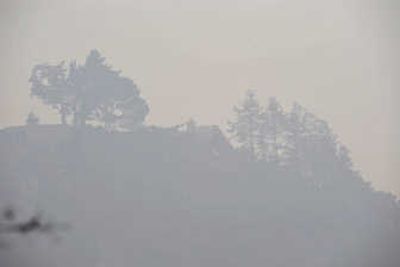Smoke, ash wreaking havoc on California air quality

FRESNO, Calif. – California’s raging wildfires have created a smoky haze so stifling that some doctors in the state’s landlocked farm country say their waiting rooms have been crowding with patients struggling to breathe amid the soot-laden air.
Even without the blazes, which have scorched more than 660 square miles statewide, the farming towns and subdivisions dotting the long, flat San Joaquin Valley are typically shrouded in a layer of smog during the summer.
But airborne ash from the hundreds of lightning-sparked fires caused such a spike in air pollution over the weekend that meteorologist Shawn Ferreria said it took his breath away.
“I went and bought a mask because my lungs were not happy with me,” said Ferreria, a senior air quality specialist for the San Joaquin Valley Air Pollution Control District. “What we are experiencing is out of historical norms. I thought if I’m going to continue riding my bike to work, I better take an extra measure.”
Hundreds of firefighters were working overtime Tuesday to beat back blazes burning from the western edge of the Sierra Nevada to coastal mountains near Big Sur, where authorities enforced new, mandatory evacuations along a roughly 15-mile stretch of Highway 1.
Gov. Arnold Schwarzenegger ordered 200 National Guard troops to report for fire training Tuesday to relieve weary crews early next week. That marks the first time the Guard has been asked to send soldiers to join ground-based fire fights since 1977, a Guard spokesman said.
Officials had hoped a fog bank along the Northern California coast would help with fire suppression, but the moisture did not extend inland, said Brian Tentinger, a meteorologist with the National Weather Service.
Even as crews made headway against some of the worst blazes, air district officials grew concerned that wind patterns would send more smoke billowing into the valley, which is bordered on three sides by mountains.
Once the tiny particles of soot – which are blamed for triggering asthma and other respiratory problems – are carried inland, they’re sealed in under a layer of warm air created by hot summer temperatures.
“Our waiting rooms are full of people with sore throats, itchy eyes and sniffles,” said Kevin Hamilton, a respiratory therapist with Sequoia Community Health Center in Fresno. “It’s certainly driving the clinic’s appointments up.”
Community Regional Medical Center, the area’s only trauma center, showed no increase in respiratory cases. Some health professionals suggested that could be because asthma patients stayed inside to avoid exposure.
In the San Francisco Bay Area, officials said air quality had finally returned to healthy levels after several days of health warnings.
In the Big Sur region of the Los Padres National Forest, about 200 people were ordered to evacuate Tuesday, and evacuation orders remained in place for occupants of at least 75 homes who were forced to leave the region last week.
Endangered condors also sought to avoid the thick smoke by hunkering in cliffs along the Pacific Ocean. A 2-month-old baby condor died when fire swept through the gorge where it was nesting in a 1,000-year-old redwood, scientists said.